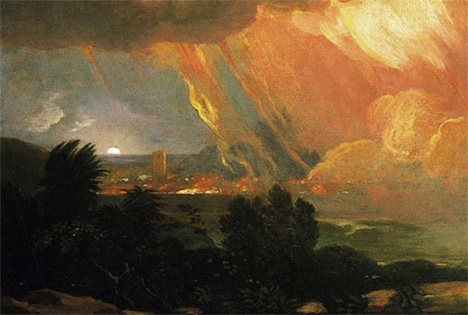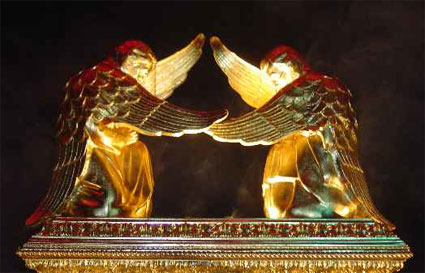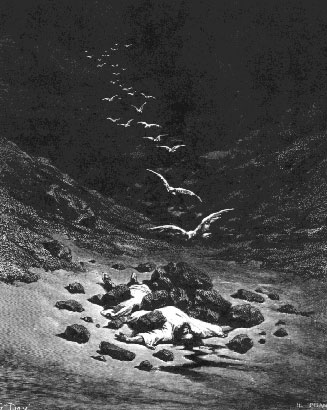Crafty Lot

Lot offering his daughters to the men of Sodom is an affront to our moral sensibilities, yet the New Testament calls him a righteous man. Could our problem be simply that the Bible is smarter than we are?

Lot offering his daughters to the men of Sodom is an affront to our moral sensibilities, yet the New Testament calls him a righteous man. Could our problem be simply that the Bible is smarter than we are?
Strange Fire
We’ve reach the central “cycle” of the book of Numbers, the attempt by Balak to destroy Israel. To the unbeliever, it is a story about a talking donkey. For believers, it is a story about a wicked prophet and a carnal people. For those with a wide angle “Bible Matrix” lens, the entire landscape suddenly comes into focus as something familiar and terrifying.
“His eyes [were] like a flame of fire …
[and] out of His mouth went a sharp two-edged sword”
(Revelation 1:14-16)
“I will set My face against you,
and you shall be defeated by your enemies.”
(Leviticus 26:17)
The Tabernacle layout to the Bible narratives is like the Globe Theatre to Shakespeare. [1] If we understand the correspondences we can get the “architectural” relationships worked out. The same blueprint appears again and again, and it explains the motivation of “righteous Lot” in the offering of his daughters to the men of Sodom. Continue reading
1 Peter 2:4-10 | Sermon Notes
I think it’s worth looking at the literary structure of this passage. Here’s a revised version of the sheet I handed out after the sermon.
As I’ve written before, modern readers (and commentators) only look at the content of the text, but the authors of Scripture also communicate to us through where they place that content within that text, i.e. how it is arranged.
Then Jerusalem, all Judea, and all the region around the Jordan went out to him and were baptized by him in the Jordan, confessing their sins. But when he saw many of the Pharisees and Sadducees coming to his baptism, he said to them, “Brood of vipers! Who warned you to flee from the wrath to come? “Therefore bear fruits worthy of repentance, ”and do not think to say to yourselves, ‘We have Abraham as father.’ For I say to you that God is able to raise up children to Abraham from these stones.” —Matthew 3:5-9
Then, as He was now drawing near the descent of the Mount of Olives, the whole multitude of the disciples began to rejoice and praise God with a loud voice for all the mighty works they had seen, saying: ” ‘Blessed is the King who comes in the name of the LORD!’ Peace in heaven and glory in the highest!” And some of the Pharisees called to Him from the crowd, “Teacher, rebuke Your disciples.” But He answered and said to them, “I tell you that if these should keep silent, the stones would immediately cry out.” —Luke 19:37-40
The Bible is consistent with its symbols, so what is it with stones crying out? Continue reading

The father of the English backpacker who was lost in the Blue Mountains wrote in the visitors book at the hotel where he stayed. He wrote that he was going briefly back into the bush to carve a memorial to his son into one of the rockfaces. Thankfully, as he waited for his flight home to the UK, his son walked out of the wilderness yesterday suffering from hunger and exposure, but alive. As I have discussed in this series [1], the Bible is full of memorials to important events.
Getting God’s people out of the wilderness is a legal procedure. A minimum of two witnesses is required. First, there are two preachers who spy out the enemy and warn them of impending judgment. The feast pattern consistently puts this at “Trumpets”, which helps us identify some of its more subtle appearances:

“And all Israel stoned [Achan and his family] with stones, and burned them with fire, after they had stoned them with stones.”
Questions from blogger Blue Ollie:
Many still claim to get their morals from the Bible. Well, what does the Bible actually say?
The following is a very incomplete list but is nevertheless a valid list.
1. How do you determine if someone is guilty? Answer: gamble.

Moses spent 40 years in the wilderness, then Israel did. God’s prophet lives through the pattern, then God’s people follow him in a larger pattern. The head of the sacrifice, then the body. The Adam, then the Greater Eve. Jesus, then the church.
James Jordan observes that the Promised Land failed to support Abram both during the famine and also later concerning the flocks of Abram and Lot. Only after the Lord “purified” the Land with a sacrifice was it again a garden for the people of God. Like Adam, a deep sleep fell upon Abram, but it was animal substitutes that were divided.
The Lord passed over Abram, but in the darkness, a smoking firepot and blazing torch passed through the divided animals. God structured this event to follow Israel’s feasts, with Passover and Atonement at each end, and the Lord’s prediction of the Hebrews’ slavery in Egypt at the “wilderness” centre.
The blazing torch and smoking firepot are the Lord’s chariot throne. The blazing torch (the head) is His throne, the Ark. The smoking firepot is the Incense Altar, the cloud of angel elders in His train (the body), the Holy Place positioned ‘underneath’ the Most Holy (see Ezekiel 1).1
Revelation 8
The third angel blew his trumpet, and a great star fell from heaven, blazing like a torch,
After the ascension of Christ, Satan was expelled from his “ministry” before God as the Accuser of man. Like the evil twin of the blazing torch that measured Abram’s sacrifices, he was then used by God to bring an end to the Old Covenant upon the Land.
And the fifth angel blew his trumpet, and I saw a star fallen from heaven to earth, and he was given the key to the shaft of the [Abyss]. He opened the shaft of the [Abyss], and from the shaft rose smoke like the smoke of a great furnace, and the sun and the air were darkened with the smoke from the shaft.
The seven trumpets are a chiasm, with the third and fifth corresponding symmetrically. The “de-Ascension” of Satan mirrors his fall in the third trumpet. Like Christ, he was given a key. His throne-coming was also accompanied by clouds of smoke, but as false High Priest, instead of a sweet-smelling aroma it was the sulphur of Sodom. As Pentecost’s fire came from the Altar of Incense in heaven, its evil twin bore an army of unholy mighty men—the “smoking firepot” body of Satan’s blazing torch head. It was the children of Satan (John 8:44), an army of Judaisers, locusts who would devour the Land. As in Daniel 7, the winds of the Spirit raised up beasts.
“as with Tyre of old, the Abyss is being dredged up to cover the Land with its unclean spirits. Apostate Israel is to be cast out of God’s presence, excommunicated from the Temple, and filled with demons. One of the central messages of Revelation is that the Church tabernacles in heaven; the corollary of this is that the false church tabernacles in hell.”2
And the armies of heaven, arrayed in fine linen, white and pure, were following him on white horses. Revelation 19:14
As the preaching of the seven-sealed Gospel to the Land began with a white horse, so at the destruction of Judaism, the preaching of the Gospel to the World began with the white horse passing through the divided pieces of the Land (Zechariah 14:4). However, this time, Christ did not ride alone but with His bride. He was a blazing torch, and She was now the smoking firepot—a permanent part of His Ark-chariot. A government of ascended men had replaced the government of angels. Together they passed through the midst of a divided Land to carry the seven seals to the World.
“Then passing through the midst of them, He went His way.” Luke 4:30
________
1 Note also that in Exodus 25-31, the Ark is the Light of Day 1, and the Incense Altar is the “swarms” of Day 5 – birds from above and fish from below. The Tabernacle was both a portable Sinai and an image of the chariot of God.
2 David Chilton, The Days of Vengeance, p. 244.

Jesus said to him, “No one, having put his hand to the plow, and looking back, is fit for the kingdom of God.” (Luke 9:62)
In Hebrews 10, the writer (most likely Paul) tells the Jewish Christians that if they turn back from following Christ they will be destroyed. Instead of offering a lame explanation to prove this passage doesn’t contradict the New Testament teaching that believers can’t lose their salvation, we should understand where the original audience was in history. If we do that, we find no explanation is necessary.
“…though Jews returned to the land after the decree of Cyrus, they did not enjoy the fruits of it (Haggai 1:1-11). They were still alienated from the land. They did not really occupy it until they rebuilt the Temple, which was completed in the sixth year of Darius, 20 years later.”1
Darius listened to those who opposed the Jews and ordered the Temple reconstruction to officially cease, so the Lord raised up two witnesses, Haggai and Zechariah. Haggai would chastise the people for neglecting the house of God, and stir up their hearts to finish it. Zechariah would deal with the spiritual war going on behind the scenes.
Zechariah’s visions perform the same function as Abram’s animal sacrifice. (In Abram’s time, there was a famine in the Land, and later it did not support Abram and Lot’s flocks). In Zechariah, the mediator who is “passed over” is not Abram but Joshua the High Priest. The sins are atoned for again, but not with animal sacrifices. In Zechariah it is the Angel of the Lord who steps in, chases away the accusations of Satan (as the ravens), and provides clean robes as a New Covenant.
Then the Temple could be completed, and the abundant fruits of a recreated Land were enjoyed by a new Israel.
________
1 James B. Jordan, Jubilee,
Biblical Chronology Vol. 5, No. 4, www.biblicalhorizons.com